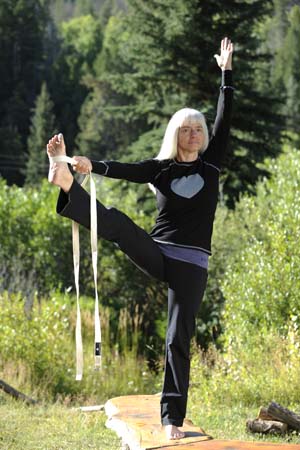 Hasta Padangusthasana (Extended Big Toe Pose) is one of a category of poses my students have named “flying poses.” Flying poses are poses that express expansion. In flying poses, the root of the pose (whatever’s on the ground) extends deep into the ground, while the rest of the body expands outward and upward, away from the earth. The opening comes from stability.
Hasta Padangusthasana (Extended Big Toe Pose) is one of a category of poses my students have named “flying poses.” Flying poses are poses that express expansion. In flying poses, the root of the pose (whatever’s on the ground) extends deep into the ground, while the rest of the body expands outward and upward, away from the earth. The opening comes from stability.
Like all balance poses, Hasta Padanghustasana develops our sense of balance. In addition, practicing Hasta Padangusthasana strengthens the legs and ankles, activates the muscles around the hip joints and stretches the hamstring muscles. Of course, if you have a recent or chronic ankle injury, you should take care in this pose. Also, if your hamstrings are tight, make sure you use a strap so that you can keep the rest of your body in integrity as you practice.
How to Practice Hasta Padangusthasana
- Begin by standing on a thin yoga mat or directly on the floor. A thin mat works better for most people because it’s easier to feel stable standing on a thinner mat. Some people balance better without a mat.
- Step your feet to hips-width apart. Close your eyes and become aware of your feet. Feel how the feet constantly make micro-adjustments in order to keep you upright. This is the nature of balance—constant, dynamic adaptation. So balance is not about reaching some “perfect” position and holding onto it; it’s about trusting your body’s own proprioceptive awareness to make the adjustments needed to keep you dynamically upright. Let your weight rest in your feet.
- Shift your body to the right, letting the weight settle into your right foot. Bend your left knee and pick your foot off the floor. Find equilibrium here. When you feel balanced, bend your left knee further until you can take hold of your left foot with your left hand. You may either hold the outside of the foot or curl your index and middle fingers around the inside of your big toe.
- If your hamstrings and inner thigh muscles are tight enough that holding your left foot and straightening your leg is currently impossible, place a strap or belt around your left foot and hold the belt with your left hand. As you unfurl your right arm and left leg, let your hand slide on the strap so that you can fully straighten your leg, while holding your foot with the strap.
- Place your right hand on your hip and again, find stability, feeling how your right foot is constantly shifting to keep your body in balance. (If balance eludes you, you may do this pose standing with your back to a wall and let your buttocks rest against the wall for additional stability.)
- Simultaneously begin to unfurl the right arm and left leg out to their respective sides so that they open gradually like a blossoming flower, until they reach full extension. Extend the arm and leg with equal intention, so that they balance each other. Continue to feed your body’s weight into your standing leg.
- In all balance poses, our minds tend to find the body parts that are moving to be most compelling. (In the above case, these would be the right arm and left leg.) The stable, standing leg is the most important part of the pose, so as you extend the right arm and left leg, keep at least half your awareness in the standing leg. This will help you maintain stability.
- When you feel stable in the pose, continue to ground your standing leg and begin to explore expansion through all the limbs, including both arms and legs, the head and the tailbone. Continue expanding as you breathe.
- You can either continue to extend your left arm out to the side at shoulder level, or if you like, you can extend the left arm up toward the sky.
- Take five to ten slow, deep breaths, directing the breath as if you can extend it out into all your limbs, including your head and tailbone.
- Then release your hold on the left leg, letting your left foot return to the floor. Return to standing equally on both feet and let your arms rest at your sides. Close your eyes and feel what happened in the pose. How has your body/mind changed? Then repeat the pose on the other side.
Expansion comes from stability. Every tree and flower expands from its roots. So do our bodies. Hasta Padangusthasana teaches us about the dynamic relationship between stability and openness. Explore this relationship in your yoga practice, and watch how it expands into the rest of your life.
Updated article from April 13, 2010
